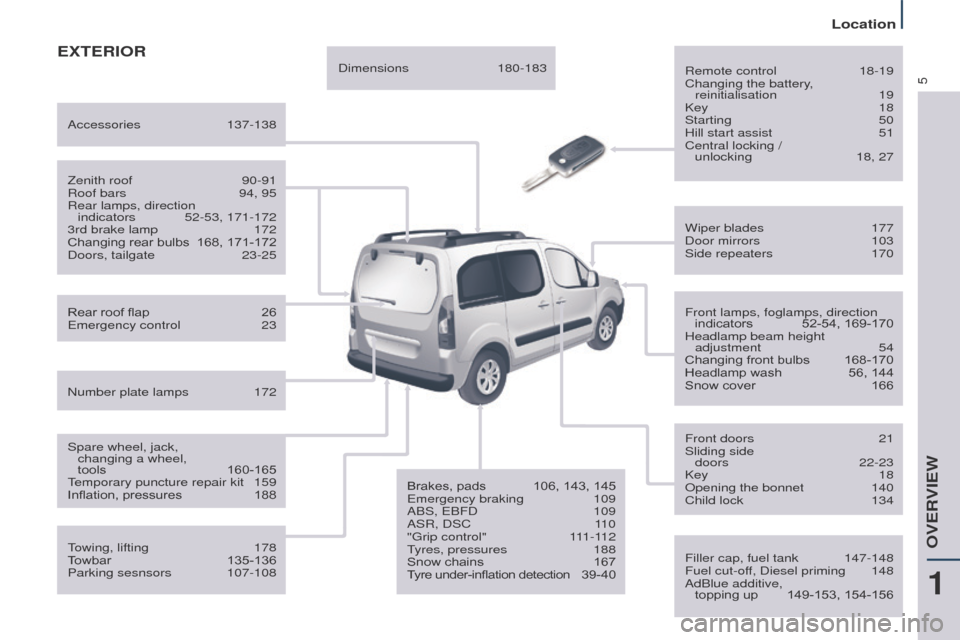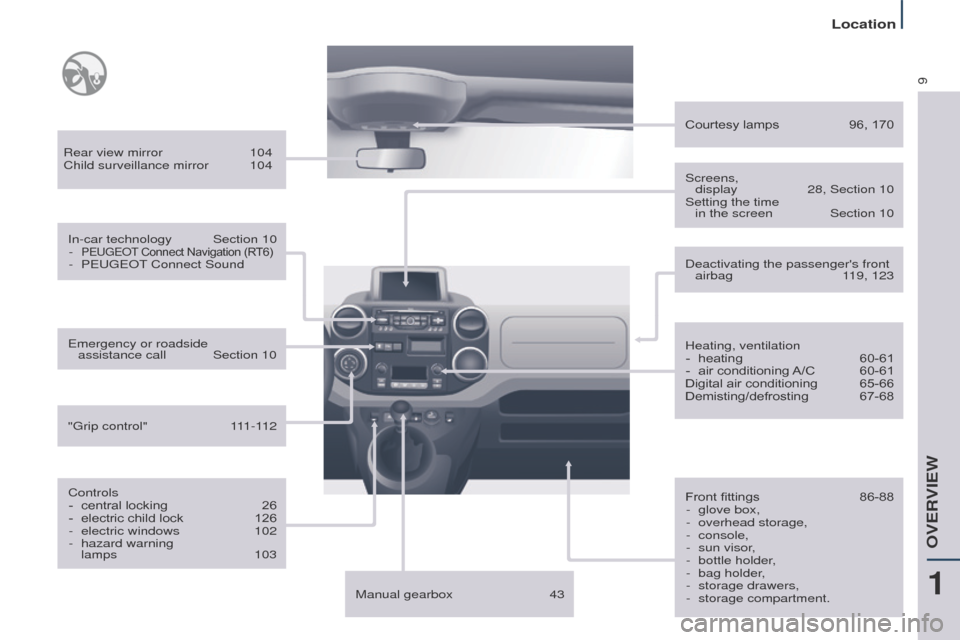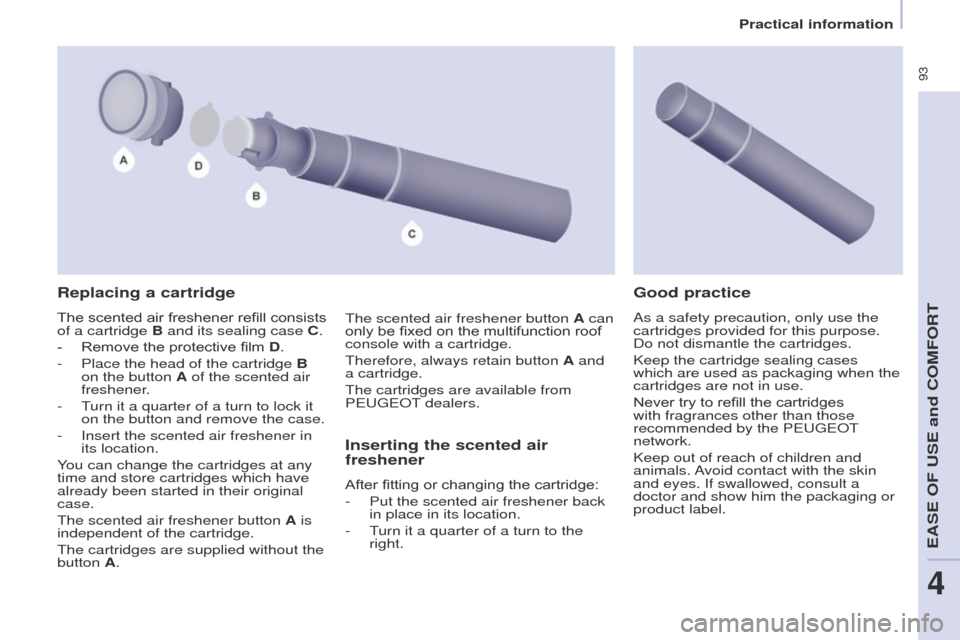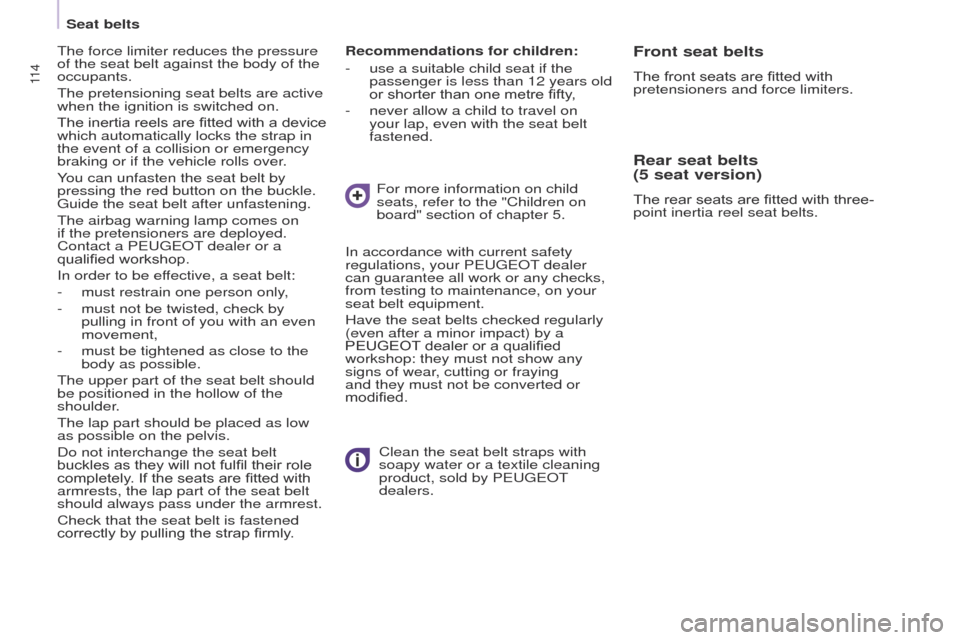child lock Peugeot Partner Tepee 2015 Owner's Manual
[x] Cancel search | Manufacturer: PEUGEOT, Model Year: 2015, Model line: Partner Tepee, Model: Peugeot Partner Tepee 2015Pages: 276, PDF Size: 12.76 MB
Page 4 of 276

2
Partner_2_VP_en_Chap00a_Sommaire_ed02-2014
Key 18
Alarm 20
Doors
21tailgate
23
Rear roof flap
26
Central locking
27
Instrument panel
28
Adjusting the time
29
W
arning lamps
30
Fuel gauge
38
Coolant
38
Under-inflation detection
39
Service indicator
41
Lighting dimmer
42
Steering
wheel adjustment
43
Manual gearbox
43g
ear shift indicator
44
6-speed electronic
gearbox
45
Stop & Start
47
Starting and stopping
50
Hill start assist
51Lighting control
52
wipers 55
Cruise control
57
Speed limiter
60
Heating /
Air conditioning
manual
63 digital
65
Demisting and defrosting
6
7
Front seats
69
Rear bench seat
71
Rear seats
(5 seat version)
74
Rear seats
(7 seat version)
77
Modularity
84
Front fittings
86
Zenith roof
90
Roof bars
95
Courtesy lamps
96
Load space cover
(5 seat version)
97
Load space cover
(7 seat version)
101
Mirrors
103e
lectric windows
105
READY
TO SET OFF
3.
18-51 SAFETY
5.
106-134
Locatione
xterior 5
Interior
6
Instruments and controls
8technical data - Maintenance
12
Instruments and controls Left hand drive
13
Right hand drive
14
OVERVIEW
1.
4-14
Hazard warning lamps 106
Parking brake 106
Parking sensors
107
Anti-lock braking system (ABS)
109
e
mergency braking assistance
109
ASR and DSC
1
10
g
rip control
1
11
Seat belts
1
13
Airbags
1
16
Child seats
120
Deactivating the passenger's
front airbag
1
23
Recommended seats
126
Installation
128
ISOFIX seats
132
Child lock
134
EASE OF USE and
COMFORT
4.
52-105
2.
15-17
ECO-DRIVING
environment 15
Eco-driving 16
t
he "Visual Search " (visual
index) section assists
you in finding the controls
and functions and their
associated page numbers
on the schematic outlines of
the vehicle.
Contents
Page 7 of 276

5
Partner_2_VP_en_Chap01_vue-ensemble_ed02-2014
EXTERIOR
Remote control 18-19
Changing the battery ,
reinitialisation
19
Key
18
Starting
50
Hill start assist
51
Central locking /
unlocking
18, 27
Filler cap, fuel tank
147-148
Fuel cut-of
f, Diesel priming
148
AdBlue additive,
topping up
149-153, 154-156
Wiper blades
177
Door mirrors
103
Side repeaters
170
Front lamps, foglamps, direction indicators
52-54, 169-170
Headlamp beam height adjustment
54
Changing front bulbs
168-170
Headlamp wash
56, 144
Snow cover
166
Front doors
21
Sliding side
doors
22-23
Key
18
Opening the bonnet
140
Child lock
134
towing, lifting
178
T
owbar
135-136
Parking sesnsors
107-108
Rear roof flap
26e
mergency control
23
Spare wheel, jack,
changing a wheel,
tools
160-165temporary puncture repair kit
159
Inflation, pressures
188
Zenith roof
90-91
Roof bars
94, 95
Rear lamps, direction
indicators
52-53, 171-172
3rd brake lamp
172
Changing rear bulbs
168, 171-172
Doors, tailgate
23-25
Accessories
137-138
Number plate lamps
172 Dimensions
180-183
Brakes, pads
106, 143, 145e
mergency braking
109
ABS,
e
BFD
109
ASR, DSC
1
10
"
g
rip control"
1
11-112
tyres, pressures
188
Snow chains
167
T
yre under-inflation detection
3
9-40
1
OVeRVIeW
Location
Page 11 of 276

9
Partner_2_VP_en_Chap01_vue-ensemble_ed02-2014
Rear view mirror 104
Child surveillance mirror 104
In-car technology
Section 10
-
PeugeOt Connect Navigation (R T6)- PeugeO t Connect Sound
Controls -
central locking
26
-
electric child lock
126
-
electric windows
102
-
hazard warning
lamps
103
e
mergency or roadside assistance call
Section 10
"
g rip control"
1
11-112 Heating, ventilation
-
heating
60-61
-
air conditioning
A/C
60-61
Digital air conditioning
65-66
Demisting/defrosting
67-68
Courtesy lamps
96, 170
Front fittings
86-88
-
glove box,
-
overhead storage,
-
console,
-
sun visor
,
-
bottle holder
,
-
bag holder
,
-
storage drawers,
-
storage compartment.
Screens,
display
28, Section 10
Setting the time
in the screen
Section 10
Deactivating the passenger's front airbag
1 19, 123
Manual gearbox
43
1
OVeRVIeW
Location
Page 13 of 276

11
Partner_2_VP_en_Chap01_vue-ensemble_ed02-2014
Fuses, dashboard, cabin 173-175
Bonnet release lever
140
Front fititngs
86-88
-
glove box,
-
roof storage,
-
console,
-
sun visor
,
-
bottle holder
,
-
bag holder
,
-
storage drawers,
-
storage compartment.
Rear view mirror
104
Child surveillance mirror
104
e
mergency or assistance
call
Section 10
Manual gearbox
43
technology on-board
Section 10
-
PeugeOt
Connect Navigation (R T6)- PeugeO t Connect Sound (RD5)
Controls -
central locking
26
-
electric child lock
126
-
electric windows
102
-
hazard warning lamps
103
"
g rip control"
1
11-112
Heating, ventilation -
heating
60-61
-
air conditioning
A/C
60-61
Digital air conditioning
65-66
Demisting-defrosting
67-68
Courtesy lamps
96, 170
Screens,
display
28, Section 10
Setting the time in
the screen
Section 10
1
OVeRVIeW
Location
Page 15 of 276

13
Partner_2_VP_en_Chap01_vue-ensemble_ed02-2014
INSTRUMENTS AND CONTROLS
1. Lighting and direction indicator
stalk.
2.
Instrument panel with screen.
3.
Wipers, screenwash, trip
computer control stalk.
4.
Ignition.
5.
Audio system controls.
6.
Driver's front airbag, horn.
7.
Steering wheel height and reach
adjustment.
8.
Cruise control, speed limiter
controls.
9.
Switch panel, parking sensors,
headlamp beam adjustment,
e
SC, Stop & Start.
10.
Bonnet
release.
11 .
e lectric door mirror adjustment.
12.
e lectric window switches.
13.
Switch panel: hazard warning
lamps, central locking, child lock.
14.
Cigarette
lighter.
15.
Heating-ventilation
controls.
16.
Storage
compartment.
17.
e lectronic gearbox controls or
g
rip control.
18.
Audio
equipment.
19.
Screen.
20.
e mergency or assistance call.
1
OVeRVIeW
Presentation
Page 16 of 276

14
Partner_2_VP_en_Chap01_vue-ensemble_ed02-2014
INSTRUMENTS AND CONTROLS
1. Lighting and direction indicator
control stalk.
2.
Instrument panel with screen.
3.
Wiper
, screenwash, trip
computer control stalk.
4.
Ignition switch.
5.
Audio system controls.
6.
Driver's front airbag, horn.
7.
Steering wheel height and reach
adjustment.
8.
Cruise control, speed limiter
controls.
9.
Switch panel, parking sensors,
headlamp beam adjustment,
e
SC, Stop & Start, alarm.
10.
Bonnet release lever
.
11 .
e lectric door mirror controls.
12.
e lectric window switches.
13.
Switch panel: hazard warning,
central locking, child lock.
14.
Cigarette
lighter.
15.
Heating-ventilation
controls.
16.
Door
pockets.
17.
e lectronic gearbox controls or
g
rip control.
18.
Audio
system.
19.
Screen.
20.
e mergency or assistance call.
Presentation
Page 22 of 276

20
Partner_2_VP_en_Chap03_Pret-a-partir_ed02-2014
When leaving the vehicle, check that
the lamps are off and nothing of value
is visible.
As a safety precaution (with children
on board), remove the key from the
ignition when leaving the vehicle, even
for a short time.
Good practice
Do not make any modifications to the
electronic immobiliser system.
Operating the remote control, even
when it is in your pocket, may result in
involuntary unlocking of the doors.
t
he simultaneous use of other
high frequency equipment (mobile
telephones, domestic alarms…), may
interfere with the operation of the
remote control temporarily.
t
he remote control does not operate
while the key is in the ignition, even if
the ignition is off.
ELECTRONIC IMMOBILISER
All of the keys contain an electronic
immobiliser device.
t
his device locks the engine supply
system. It is activated automatically
when the key is removed from the
ignition.
After the ignition is switched on, a
dialogue is established between the
key and the electronic immobiliser
system.
t
he metal part of the key must be
unfolded correctly for correct dialogue
to take place.
If you lose your keys
Visit a P
euge O t
dealer with the
vehicle's V5 registration document and
your identification document.
A
P euge O t
dealer will be able
to retrieve the key code and
the transponder code so that a
replacement key can be ordered. When purchasing a second-hand
vehicle:
-
have the keys memorised by a
P
euge O t
dealer to ensure that
the keys in your possession are
the only ones which can start the
vehicle.
ALARM
If fitted on your vehicle, this provides
two types of protection:
-
exterior protection: it sounds if a
front/rear door or the bonnet is
opened.
-
interior protection: it sounds if
the volume inside the passenger
compartment changes (breaking of
a window or a movement inside the
vehicle).
If
your vehicle is fitted with a separation
partition, the interior protection is not
active in the load space.
Locking the vehicle with
complete alarm
Setting the alarm
- Switch of f the ignition and get out of
the vehicle.
-
Set the alarm within five minutes of
getting out of the vehicle, by locking
or deadlocking using the remote
control.
t
he red L e D, located in the
button, flashes once per second.
Access
Page 95 of 276

93
Partner_2_VP_en_Chap04_ergonomie_ed02-2014
Replacing a cartridge
The scented air freshener refill consists
of a cartridge B and its sealing case C.
-
Remove the protective film
D.
-
Place the head of the cartridge
B
on the button A of the scented air
freshener.
-
t
urn it a quarter of a turn to lock it
on the button and remove the case.
-
Insert the scented air freshener in
its location.
Y
ou can change the cartridges at any
time and store cartridges which have
already been started in their original
case.
t
he scented air freshener button A is
independent of the cartridge.
t
he cartridges are supplied without the
button A.
Inserting the scented air
freshener
After fitting or changing the cartridge:
-
Put the scented air freshener back
in place in its location.
-
t
urn it a quarter of a turn to the
right.
Good practice
As a safety precaution, only use the
cartridges provided for this purpose.
Do not dismantle the cartridges.
Keep the cartridge sealing cases
which are used as packaging when the
cartridges are not in use.
Never try to refill the cartridges
with fragrances other than those
recommended by the P
euge O t
network.
Keep out of reach of children and
animals.
Avoid contact with the skin
and eyes. If swallowed, consult a
doctor and show him the packaging or
product label.t
he scented air freshener button A can
only be fixed on the multifunction roof
console with a cartridge.
t
herefore, always retain button A and
a cartridge.
t
he cartridges are available from
P
euge
O
t
dealers.
Practical information
eASe OF uSe and COMFORt
4
Page 116 of 276

11 4
Partner_2_VP_en_Chap05_Securite_ed02-2014
Recommendations for children:
-
use a suitable child seat if the
passenger is less than 12 years old
or shorter than one metre fifty
,
-
never allow a child to travel on
your lap, even with the seat belt
fastened. For more information on child
seats, refer to the "Children on
board" section of chapter 5.
Clean the seat belt straps with
soapy water or a textile cleaning
product, sold by P
euge O t
dealers.
In accordance with current safety
regulations, your P
euge O t
dealer
can guarantee all work or any checks,
from testing to maintenance, on your
seat belt equipment.
Have the seat belts checked regularly
(even after a minor impact) by a
PEUGEOT
dealer or a qualified
workshop: they must not show any
signs of wear, cutting or fraying
and they must not be converted or
modified.t
he force limiter reduces the pressure
of the seat belt against the body of the
occupants.
t
he pretensioning seat belts are active
when the ignition is switched on.
The inertia reels are fitted with a device
which automatically locks the strap in
the event of a collision or emergency
braking or if the vehicle rolls over.
You can unfasten the seat belt by
pressing the red button on the buckle.
g
uide the seat belt after unfastening.
t
he airbag warning lamp comes on
if the pretensioners are deployed.
Contact a P
euge
O
t
dealer or a
qualified workshop.
In order to be ef
fective, a seat belt:
-
must restrain one person only
,
-
must not be twisted, check by
pullin
g in front of you with an even
movement,
-
must be tightened as close to the
body as possible.
t
he upper part of the seat belt should
be positioned in the hollow of the
shoulder.
t
he lap part should be placed as low
as possible on the pelvis.
Do not interchange the seat belt
buckles as they will not fulfil their role
completely. If the seats are fitted with
armrests, the lap part of the seat belt
should always pass under the armrest.
Check that the seat belt is fastened
correctly by pulling the strap firmly.Front seat belts
The front seats are fitted with
pretensioners and force limiters.
Rear seat belts
(5 seat version)
The rear seats are fitted with three-
point inertia reel seat belts.
Seat belts
Page 135 of 276

133
Partner_2_VP_en_Chap05_Securite_ed02-2014
ADVICE ON CHILD SEATS
At the rear, always leave sufficient
space between the front seat and:
-
a "rearward facing" child seat,
-
the feet of a child seated in a
"forward facing" child seat.
For this, move the front seat forward
and, if necessary
, straighten its
backrest as well.
t
he incorrect installation of a child seat
in a vehicle compromises the child's
protection in the event of an accident.
Check that there is no seat belt or seat
belt buckle under the child seat, as this
could destabilise the seat.
Remember to fasten the seat belts or
the child seat harnesses keeping the
slack relative to the child's body to a
minimum, even for short journeys.
For the installation of a child seat using
the seat belt, ensure that the seat belt
is well tensioned on the child seat
and that it is holding the child seat
firmly against the vehicle's seat. If the
passenger seat is adjustable, move it
forward if necessary. For the optimum installation of a
"forward facing" child seat, ensure that
the back of the child seat is as close as
possible to the backrest of the vehicle's
seat, or in contact if possible.
t
he head restraint must be removed
before installing a child seat with a
backrest on the passenger seat.
e
nsure that the head restraint is
stowed or attached securely so that it
is not thrown around the vehicle in the
event of sharp braking.
Refit the head restraint as soon as the
child seat is removed.Children at the front
the legislation on carrying a child on
the front passenger seat is specific to
each country
. Refer to the legislation in
force in your country.
Deactivate the passenger's airbag
when a "rearward facing" child seat is
installed on the front seat.
Otherwise, the child would risk being
seriously injured or killed if the airbag
were deployed.
Installing a booster seat
the chest part of the seat belt must
be positioned on the child's shoulder
without touching the neck.
e
nsure that the lap part of the seat belt
passes correctly over the child's thighs.
P
euge O t
recommends the use of a
booster seat which has a back, fitted
with a seat belt guide at shoulder level.
As a safety precaution, never leave:
-
one or more children alone and
unsupervised in a vehicle,
-
a child or an animal in a vehicle
which is exposed to the sun, with
the windows closed,
-
the keys within reach of children
inside the vehicle.
to prevent accidental opening of the
doors, use the "Child Lock".
take care not to open the rear windows
by more than one third.
to protect young children from the rays
of the sun, fit side blinds to the rear
windows.
For an installation in row 3, put the
backrests of the outer and centre
seats in row 2 in the table position, or
remove these seats in row 2, so that
the child seat or the child's legs do not
touch the seats in row 2.
Child safety
SAFetY
5